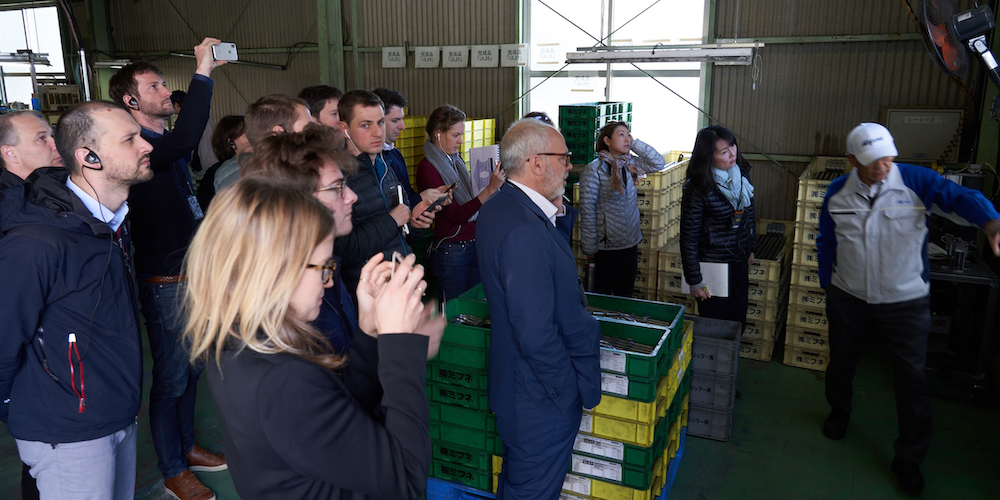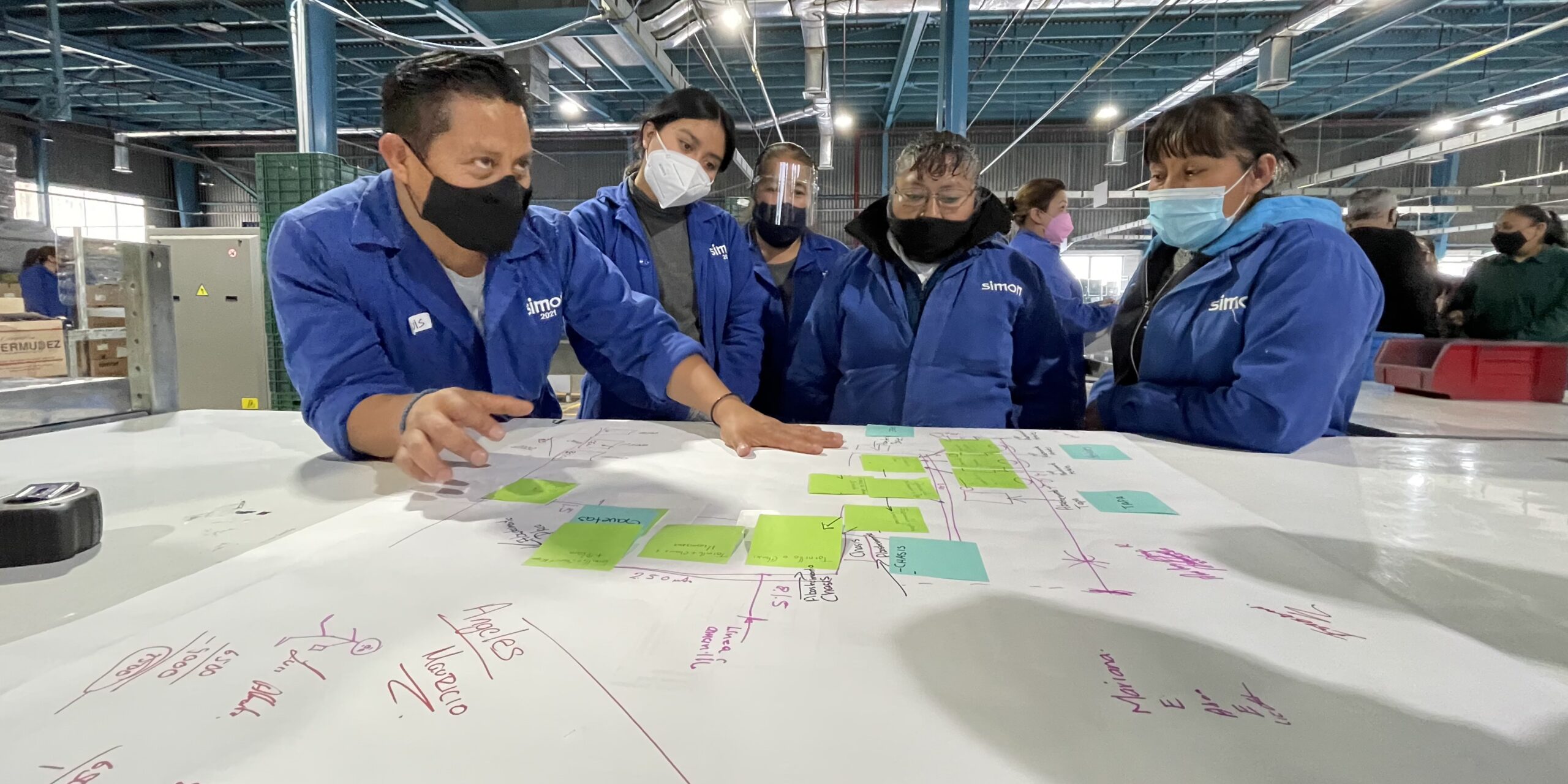
When startups visit Toyota
FEATURE – Digital organizations are starting to recognize that Toyota’s unique approach can show them the way forward, just like it does “traditional” organizations. Here, we hear from a few startup CEOs following their trip to Japan.
Words: Sandrine Olivencia, executive coach and member of Institut Lean France; Lucie Notaro, lean enthusiast; and Régis Medina, lean coach and lean IT expert at Institute Lean France.
In April 2019, a group of CEOs and lean practitioners went on a study tour to Nagoya to get some insights from Toyota and its ecosystem and to witness the Toyota Production System and the Toyota way firsthand.
In this article, we have compiled some of the key lessons participants took home, as we believe they are a great example of how much startups can learn from a “traditional” lean environment.
Our learning expedition began with a presentation of Takao Sakai on Toyota Product Development, which – we quickly realized – you have to clear about before approaching TPS. Takao’s main insight is that you need not optimize your production system before you have a great product (one that brings the most value to customers and give you margins that enable you to run your business). In this sense, TPD is an offensive process whereas TPS is defense mechanism.
Rodolphe Darves-Bornoz, CEO of Sipios, an agile tech company providing digital financial services for banks and insurances, commented: “Sakai’s presentation inspired me to take Sipios to the next level. Since our trip to Japan, we have muscled up our product conception methodology. Rather than simply shipping features, our product experts now build compelling business cases to make sure the products we build deliver actual value.”
David Sobel, President of the Other Store, a consulting company that helps brands build their best omni-channel experience and boost their sales, said: “I was motivated to take our Product Development Strategy one step further by implementing a product takt to encourage innovation. We want to deliver improvement of our clients’ websites on a regular basis to make sure they are ahead of things.”
The importance of making a great product was emphasized in every plant we visited. At Isuzu steel, a facility that receives metal coils and transforms them into metal sheets, a high sense of purpose is given to employees:
- In the main warehouse, a big board shows how the metal sheets are transformed. Isuzu asked their clients to send finished parts so that employees could better understand the contribution of their job. On the board, you can see, for instance, the central pillar of a car, with a poster next to it showing the finished car and where that specific part is located. This is not only about giving purpose, but also about highlighting the importance of quality.
- In the cafeteria, everyone can see a vision board outlining the challenges that Isuzu steel will be facing in the future, such as the decrease in steel usage and the increase in aluminum. The plant has developed a vision of what society may look like in 2030 and how Isuzu could serve it, through recycled plastic for example.
Jonathan Vidor, CEO of JVWEB, an agency specializing in e-marketing, helping clients with search engine advertising and optimization, shared his thoughts on this: “I realized the importance of providing a clear vision to the team. To do so, our head of HR Tiffany Guilpain and I wrote the definition of success at JVWEB and displayed it in the lobby of the company for everyone to see.”
To survive, many of the companies we visited have pivoted several times, showing great resilience to adapt to changing market conditions. The most striking example was Avex, a 70-year-old company that started as a sewing machine parts producer and is now producing mainly automotive parts.
The purpose of the companies we visited in the Toyota ecosystem goes beyond offering great products. They all have a high sense of responsibility in the local community. The president of Avex explained that he strives to provide people with life-long employment and take full responsibility for their well-being and development. In 2008, Avex lost 70% of its business and yet nobody got fired.
Benoît Limare, CEO of Sicara, a firm specializing in Artificial Intelligence and data science, explained: “I was impressed by the calm with which these Japanese lean leaders reinvented their business every so often in order to survive. I am aware of growing market pressure and competitors can catch up with us when we least expect it. The AI market is starting to change. So, I added a competitors’ wall in our Obeya and introduced weekly discussions with Sicara’s management team about external challenges in order to remain competitive and find new growth opportunities.”
To remain competitive, Avex heavily relies on multi-skilled employees who can do kaizen. A Toyota supplier for 30 years now, Avex is asked to reduce their price by 1% every six months. Being able to rapidly adapt is critical to their survival and can only be achieved if everyone is engaged in continuous improvement. As the president of Avex told us: “There is no end to Kaizen and everyone has to do Kaizen.” Kaizen is a way to get everyone to voluntarily take part in the team’s success. In order to develop a Kaizen attitude, Avex creates the right conditions and provides encouragement. For example, they select key employees to participate in Quality Control (QC) Circles and reward the best ideas by displaying them in the meeting room and organizing Kaizen award ceremonies four times a year. The employees will not have financial incentives to do Kaizen, as this is considered part of their job. However, Avex makes sure to equip its people with Kaizen capabilities so that they will be more likely to stay with the company.
Jean-Baptiste Limare, Head of Veygo, an online service providing short-term insurance for learner drivers, car sharing and car rentals, said: “Engaging people in Kaizen activities is key to motivating them and fostering innovation. At Veygo, I have been looking for ways to get people more engaged in continuous improvement: the Avex visit made me realize that Kaizen is not just about solving big and complex problems, but about finding ingenious solutions to small, specific and local problems, and that it concerns everyone in the organization. With the management team at Veygo, we are now focused on creating a kaizen culture where we support and reward the small kaizen actions as much as (if not more than) the big improvement initiatives.”
An essential enabler to Kaizen is visual management. Netoff, a Japanese Amazon-like online reseller of second-hand books and records (part of the ReNet Japan Group), shared with us how Just-In-Time enables effective visualization and thus Kaizen.
In order to implement Just-In-Time, they followed these steps:
- Streamline and simplify the flow of work, from order to delivery;
- Synchronize activities to takt time in order to reduce the wait in the process (15 minutes per unit = 40 books, for Renet);
- Level the workload to reduce variation.
With JIT, work can always be done under the same conditions, which enables Netoff’s employees and managers to quickly spot abnormalities and react accordingly. Shortening the takt time is the best way to see all the problems surface and have many opportunities to do Kaizen. To reveal such abnormalities, Netoff has put in place a solid visual management system:
- Hourly production targets where employees can see hour by hour if they are reaching their goals. This board is on the way to the break room, so employees can see it.
- Small tables and boxes used to show delays. For instance, the number of boxes on the conveyor shows whether or not the operator is behind.
- Work progress board that every employee updates after each “production” unit (ie. small batch of books). It shows if they are on time compared to the target line and also displays the standard number of cycles per day per person.
Once a problem is visible, it should be solved on the spot, by the team and with the support of managers. As our guide (the CEO of Netoff himself) explained to us: “Teamwork is not ‘helping’ others, which would mean feeling superior, but rather considering the other as a partner and having compassion and consideration for fellow workers who work as hard as us.” For instance, one work progress board at Netoff is the picking cycle analysis board. When someone is behind target, everyone is able to visualize it and help. It is not to be considered an evaluation tool, but a way to encourage teamwork and foster a Kaizen culture.
Baptiste Michel, CEO of BAM, a tech company helping startups and big corporates to rapidly launch mobile products, commented: “I want to focus our energy on quality, which is key to BAM’s success, through Kaizen. This will generate the spontaneous and full involvement of every team member. My first step is to study more deeply the TPS system, and then to involve my management team in doing the same.”
Lean thinking enables workers to inspect their own work to meet their objectives and propose better ways to do it to up the game, but it is also about leaders going to the gemba to do Kaizen. Mr. Amezawa, who was the director of a Toyota plant in Kentucky and took it from 8% defect to only 2% within a year, shared with us his perspective on the Toyota genchi genbutsu (go & see) culture.
When he joined Toyota in 1964, as he explained to us, the other managers were just reading the newspapers with their feet up on the desk until noon. Taiichi Ohno, the father of TPS, was then known to be gentle to floor people but tough on managers. He and Mr. Toyoda were on the gemba every day. When visiting a plant, Mr. Ohno would ignore the formal presentation, preferring to go straight to the shop floor. When he stopped to look at a problem, he would ask what it was, but he would not offer any guidance. Instead, he would draw a chalk circle near the workstation, put the manager in the center of it, and say: “Do you see a problem with the process?” The manager would be asked to stay in the circle for one hour to watch, until Mr. Ohno came back and asked him again: “Did you find the problem? Then why are you still standing in the circle?”.
Jean-Baptiste Limare had this to say about go see: “I try to practice genchi genbutsu and go to every part of my organization, every day. Among my teams are developers, and I felt that I did not understand their job well enough to be able to challenge and help them. So, I started taking coding lessons. They have helped me get familiar with the gestures and flow of development work and have been really helpful for my gemba walks.”
Benoît Limare, CEO of Sicara, added: “I created a gemba walk schedule with a takt time that is displayed in our Obeya. Every week, my business partner and I go to gemba to see one or two functions in our organization and better understand what the strengths and weaknesses of our business are.”
Leaders will make the wrong decisions if they have the wrong information. Unfortunately, reports don’t give them the whole picture. In order to lead a company effectively, managers must go to the gemba daily and get an idea of the real difficulties people encounter in their work. The presidents of the companies we visited in Japan all go to gemba every day (in fact, most of them took the time to give us a tour of their plant). What was very surprising is that they knew and could explain very specific details about the work and the techniques used by their teams.
Another striking thing was that no one seemed tense because the “big boss” was right there on the shop floor. They talked and laughed with people, and discussed with them several aspects of the work. That’s how you know a gemba walk is not a once-a-year photo op! The leaders we met all displayed passion and pride for how their products are manufactured and for the cool ideas their people come up with to improve the production system. They showed genuine interest in their plants, clients and employees. This is perhaps what most of us will remember from this trip.
Toyota – and the companies in its ecosystem – continue to remain a model for our community, and you don’t need to be a manufacturer or a hospital to learn from it. Just look at the startups that joined us in Japan!
THE AUTHORS



Read more


FEATURE - In this new series, our Polish colleagues draw on their experience with customers and discuss the most common mistakes people make in their lean implementations.


ROUND-UP – Our editor looks back at the most insightful articles Planet Lean has published on the most talked-about company in the lean world. Here are eight key lessons from Toyota, straight from our archives.


CASE STUDY – Starting in January this year, the Mexican plant of this manufacturer of lighting and electrical solutions has initiated a lean transformation that has already led to impressive results in terms of productivity.

